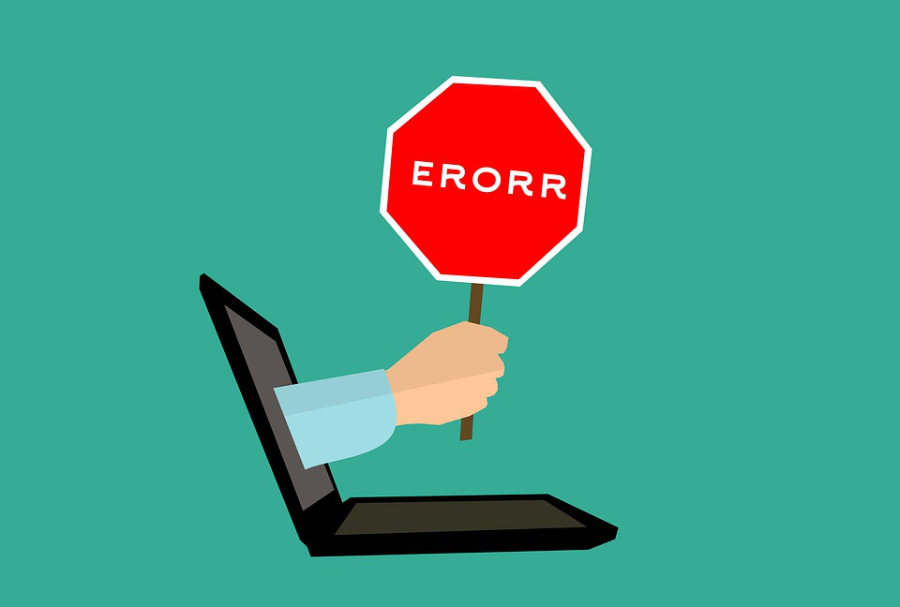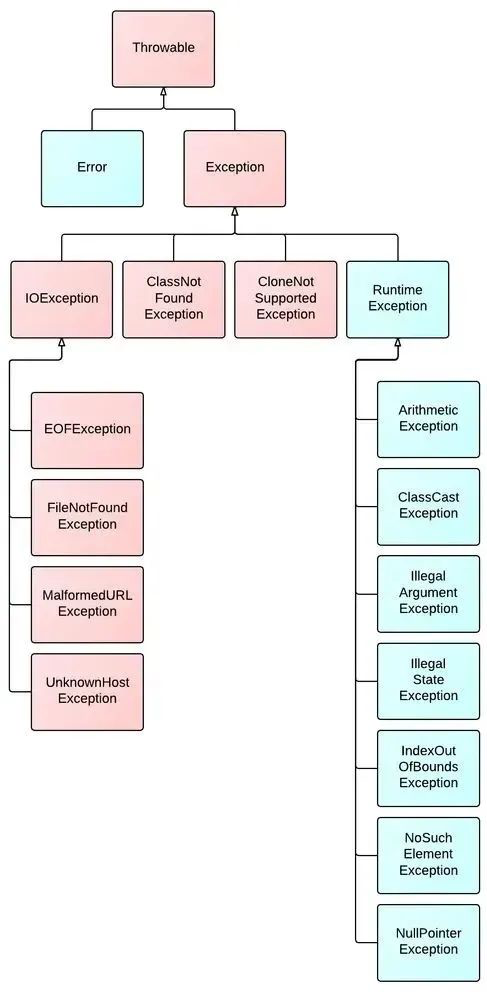最常见的10种Java异常问题
前言
本文总结了有关Java异常的十大常见问题。
目录
- 检查型异常(checked) vs. 非检查型异常(Unchecked)
- 异常管理的最佳实践箴言
- 为什么在try代码块中声明的变量不能在catch或者finally中被引用?
- 为什么 Double.parseDouble(null) 和 Integer.parseInt(null) 抛出的异常不一样呢?
- Java中经常使用的运行时异常
- 我们可以在同一个catch子句中捕获多个异常吗?
- 在 Java 中构造方法能抛出异常吗?
- 在 final 代码块中抛出异常
- try语句有return那么finally还会执行吗?
- 为何有些开发人员对异常置之不理?
1.检查型异常(checked) vs 非检查型异常(Unchecked)
简单来说,对于检查型异常, 一般在 编译期 就会被检查到,所以我们肯定会提前在方法内进行捕获处理,或者在方法头部申明并抛出。而非检查型异常,往往无法提前预知,例如被除数是0、空指针等。检查型异常特别重要,它会告诉那些调用你的接口的开发者们,如何提前预知并处理好这些可能发生的异常。
例如,IOException就是常见的检查型异常,而 RuntimeException(运行时异常)就是非检查型异常。在阅读剩余部分之前你或许可以研读这份Java异常的层次结构图。
2.异常管理的最佳实践箴言
如果可以正确处理异常,则应将其捕获并处理,否则应将其抛出。
3. 为什么在try代码块中声明的变量不能在catch或者finally中被引用?
看下面这段代码,在try代码块中声明的 String s 就不能在catch中被引用, 这段代码在编译期是通不过的。
try {
File file = new File("path");
FileInputStream fis = new FileInputStream(file);
String s = "inside";
} catch (FileNotFoundException e) {
e.printStackTrace();
System.out.println(s);
}原因是你不知道在try代码块中哪个位置会引发异常, 很有可能在声明对象之前就引发了异常。对于这个特定的示例,是正确的。
4.为什么 Double.parseDouble(null) 和 Integer.parseInt(null) 抛出的异常不一样呢?
它俩抛出的异常确实不同,但这是JDK的问题,当时开发这两个接口的开发人员不是同一波,所以我们没必要去纠结这个问题。
Integer.parseInt(null);
// throws java.lang.NumberFormatException: null
Double.parseDouble(null);
// throws java.lang.NullPointerException5.Java中经常使用的运行时异常
这里列举一部分:
IllegalArgumentException ArrayIndexOutOfBoundsException
在有些场景某个目标对象不满足我们的预期,会用到这些异常,例如下面在 if 判断语句中被使用:
if (obj == null) {
throw new IllegalArgumentException("obj can not be null");6.我们可以在同一个catch子句中捕获多个异常吗?
答案是当然可以,不过如果在同一个catch子句中捕获的这些异常都直接或间接继承自同一父类,那么就只能在catch子句中捕获父类了。
// Java 7 之前需要这样
catch (AException a) {
logger.error(a);
throw new MyException("a");
catch (BException b) {
logger.error(b);
throw new MyException("b");
}catch (CException c) {
logger.error(c);
throw new MyException("c");
}
// 在Java 7中,可以捕获所有这些异常
catch(AException | BException | CException ex){
logger.error(ex);
throw new MyException(ex);
}补充说明 : 其实是这样,在 Java7 就开始支持catch子句捕获多个异常,多个异常使用 XOR符号(I) 连接,异常的发生有可能是 A | B,但不能同时出现,相当于这些异常不能是间接或直接继承自同一个父类,因为如果AB都继承同一父类,那就不能 A|B 都写上,这也是继承原则。
7.在 Java 中构造方法能抛出异常吗?
答案是当然可以,构造方法仅是一种特殊方法而已。可以参考这个示例。
class FileReader{
public FileInputStream fis = null;
public FileReader() throws IOException{
File dir = new File(".");//get current directory
File fin = new File(dir.getCanonicalPath() +
File.separator + "not-existing-file.txt");
fis = new FileInputStream(fin);
}
}8.在 final 代码块中抛出异常
下面这个写法是合法的:
public static void main(String[] args) {
File file1 = new File("path1");
File file2 = new File("path2");
try {
FileInputStream fis = new FileInputStream(file1);
} catch (FileNotFoundException e) {
e.printStackTrace();
} finally {
try {
FileInputStream fis = new FileInputStream(file2);
} catch (FileNotFoundException e) {
e.printStackTrace();
}
}
}但是为了获得更好的代码可读性,你应该将把 try-catch代码块封装成一个新方法,然后将方法调用放在finally子句中:
public static void main(String[] args) {
File file1 = new File("path1");
File file2 = new File("path2");
try {
FileInputStream fis = new FileInputStream(file1);
} catch (FileNotFoundException e) {
e.printStackTrace();
} finally {
// 封装方法
methodThrowException();
}
}9.try语句有return那么finally还会执行吗?
答案是肯定会执行。
Java官方文档描述:The finally block always executes when the try block exits
意思就是 ” 只要存在try代码块,finally代码块就一定会执行 ” ,这种特性可以让程序员避免在try语句中使用return, continue或者break关键字而忽略了关闭相关资源的操作等。
10.为何有些开发人员对异常置之不理?
很多时候会见到下面这种代码写法。允许的情况下尽可能捕获异常并且进行处理,不知道为什么很多开发人员就是这么干?
try {
...
} catch(Exception e) {
e.printStackTrace();
}忽略异常是一件很容易做到的事,虽然这种写法很常见,但不一定是正确的写法。
参考文献:
- Unchecked exceptions in Java
- The root of Java exception class hierarchy
- Java exceptions related questions in stackoverflow

